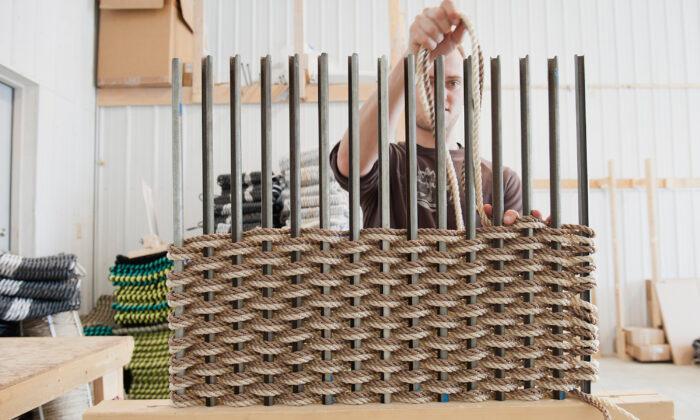As we look ahead to (hopefully) greener pastures, one thing is more evident than ever before: Our home environments matter, and in fact they play a major role in the general productivity and satisfaction levels of our everyday lives. What’s more, they prescribe or at least reflect the state of our minds and well-being: If chaos and clutter are our constant companions, their byproducts stress and anxiety promise to arrive uninvited, too.
If it took 2020’s barrage of upheavals to reveal the lack of organization and order in your home, you’re not alone. According to a survey of 2,000 homeowners by online interior design company Modsy, the pandemic made 60 percent of respondents realize their homes were disorganized, and 77 percent were so stressed by their at-home surroundings that they undertook DIY redesign projects.
There’s no better time than the dawn of a new year to make positive changes, so let the arrival of 2021 spur you to get organized and create a space you love to live in. We rounded up advice—both mindset shifts and concrete tips—from top professional designers and organizers to show you the way.

A living room in Greenwich, Conn., before and after decluttering and organizing by House to Home Organizing. Courtesy of House to Home Organizing
Decluttering Is Key
Laura Sandberg, self-proclaimed “space-solving expert” and founder of Let Laura, insists that decluttering is the first step to creating an organized home. “You need to know all the different items and quantities of what you have before you can create a proper home for them,” she says. “Being able to view your items in totality makes it much easier to go through and edit them.”Korinne Kubena Belock, founder of Urban Simplicity, a luxury home organizing company based in New York City and Palm Beach, Florida, also recommends starting with a major act of decluttering to make space for new energy in 2021.

Courtesy of Urban Simplicity
“When you’re going through the editing process, the decision to keep or toss an item isn’t always as hard as it seems,” she says. “For 75 percent of things you’re considering, it’s likely you can make a quick decision. But then there is that 25 percent—those items you, for some reason, find yourself holding onto a bit too tightly.”
As you come across such items, Belock advises asking yourself these five questions:
1. Why am I holding onto this? “Always start here. Understanding what an item means to you, whether it was a gift or represents your childhood or whatever, helps you understand the function, if any, it serves in your life at this point.”
2. When was the last time you used or wore the item? “As a standard rule, if you haven’t used or worn an item in over a year, get rid of it.”
3. Does the item no longer fit your personal style or home décor? “Times change and so does your taste. What you liked several years ago, however attached you are to the item, might not fit into your life anymore.”
4. Is there some other way to capture the memory associated with the item? “As silly as it sounds, would a photo of the item be as satisfying to you as holding onto the item?”
5. Would someone else use it and absolutely love it? “I guarantee the answer is yes. Imagine the happiness someone would feel at your local thrift store if they were able to use the item you donated. Giving back feels good, so give it a try.”
As you go, be patient with yourself—getting frustrated and giving up will only keep you in your uncomfortable situation longer.
“Most people fail to recognize how much stuff they actually have,” Sandberg says. “I like to remind clients that they didn’t get into this overnight and they aren’t going to get out of it that fast, either. Organizing is a skill that most people need to learn and then cultivate for it to be part of their routine.”
She also advises that the post-holiday cleanup is the best time of year to reconsider your hoard of holiday decor. “You know exactly what you just used and what you didn’t,” she says. “Keep this guideline in mind throughout the year and review your items at each change of season.”
It’s also a great time to declutter your kids’ collection of toys after their potential influx of gifts over the holidays, Sandberg says. Helping them go through and pick toys to donate to other kids teaches both organizational skills and generous empathy toward others.
Check Items Off Your To-Do List

Laura Sandberg tackles some planning work. Rebecca Ryan/Serving Up Social
Decluttering doesn’t only cover tangible items: Your to-do list and running mental tally of household chores to get to “someday” might need decluttering, too, says Sandberg. There’s a connection between mental and physical clutter.
“We all have things hanging around our homes that we keep meaning to do, whether it’s dropping off donations, organizing your closet, or hanging up that new beautiful family photo on your wall,” she says.
“Start getting some of these things done. Your mind and your space will feel clearer and calmer, and you will feel so productive and relieved. People don’t realize these things take up precious real estate in your home and your head, so acknowledge what you want to do and what your priorities are, then outsource the rest.”
Trick Your Mind

Take on bite-sized projects, advises Esther Konz. Courtesy of Esther Konz
Mindset matters more than you might think when it comes to organizing your home. If you don’t find ways to make the task enjoyable and rewarding, you may lose the motivation to finish what you started.
“My No. 1 tip is to start with bite-sized projects,” says Esther Konz, personal organizer and blogger at Uncluttered Simplicity. “They give you quick wins, which then inspires you to tackle those bigger projects you’ve been putting off. Tackle the junk drawer, fold and put away the laundry, make the bed, clear your bathroom counter, address a clutter hotspot or do a five-minute trash collection—a few practical examples that will only take five minutes.”
“I suggest setting the smartphone timer,” adds Ben Soreff, professional organizer and founder of House to Home Organizing. Set a time limit for a task and keep it within that frame; most tasks take as much time as you allot for them, so set reasonable goals and stick to them.
Do Double-Duty With Furniture Storage

Storage ottomans can do double duty. Courtesy of Modsy
Now that you’ve rid your home of anything unnecessary, take stock of what you do need to keep. Where are you going to put it? If your cabinets and closets are still too full for comfort, you may just need better storage solutions.
Modsy recommends turning to multipurpose furniture, especially versatile pieces such as storage furniture and murphy beds. Utilize storage in strategic ways by rethinking where you place storage pieces in your home, and moving furniture to wherever you have the biggest need.
For example, Modsy shares that entryways are an often overlooked yet highly trafficked area, so moving a piece of storage furniture—such as a credenza or extra dresser—into your home entry area can capture the detritus we all shed upon returning home, becoming a sort of “drop zone” to protect the rest of your home from scattered, out-of-place belongings.
And when it comes to storage and organization solutions, it’s important to organize before you buy, according to Sandberg.
“People love to buy product solutions before doing the physical and emotional work of organizing,” she says. “If you declutter first and understand the types and quantities of items you need to store, it will be so much easier and more efficient to purchase or repurpose optimal solutions.” And make sure to measure before purchasing, to skip the hassle of returns.
Reconfigure Your Kitchen Junk Drawer
Don’t neglect the clutter behind closed drawers: that dreaded junk drawer may not be adding to the visual clutter of your home, but awareness of its presence could be dragging you down mentally.“Turn the kitchen junk drawer into the utility drawer,” says Soreff. “There is no other way around the challenge than to take everything out and sort it for review. After you have kept a reasonable amount of office, tools, and tech supplies, get some drawer dividers or organizers to keep items grouped. This will also serve to place a limit on items—for instance, if the battery bin is full, you don’t need to buy more.”
Reorganizing your home won’t just make you feel better—it may save you money, too.
Skye Sherman is a freelance travel writer based in West Palm Beach, Fla. She covers news, transit, and international destinations for a variety of outlets. You can follow her adventures on Instagram and Twitter @skyesherman





